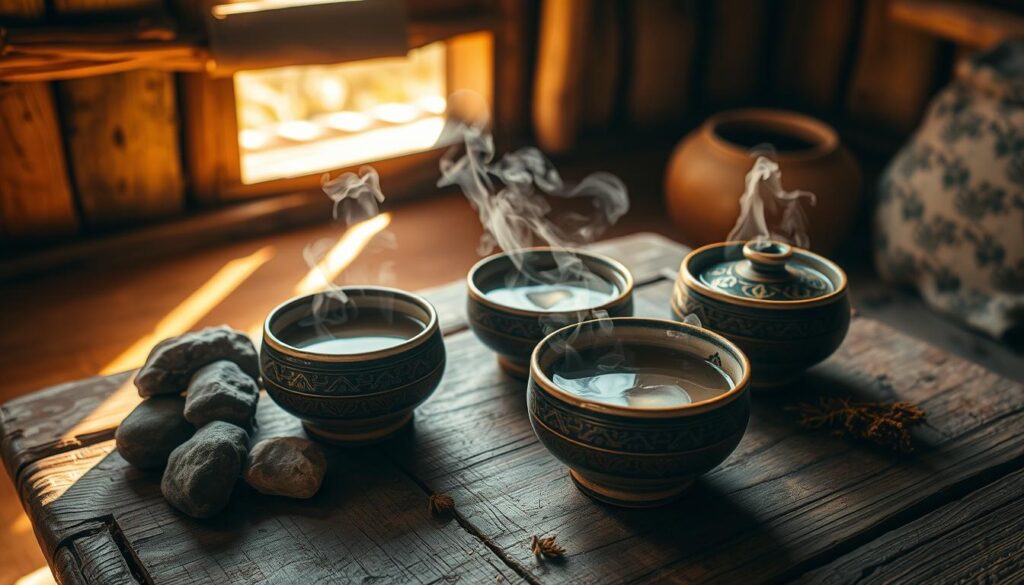We’re diving into the fascinating world of suutei tsai, a traditional beverage that stands apart from the sweet bubble teas popular in the West. This savory drink reflects the nomadic heritage of Mongolia‘s people and has been central to hospitality for centuries.
The cultural significance of this unique milk tea is rooted in its ingredients and preparation methods, which have evolved over time while maintaining their importance in both rural and urban households. By exploring the historical context and modern adaptations of this beverage, we gain insight into its role as a cornerstone of daily life.
For those looking to expand their culinary horizons, this traditional drink presents an opportunity to experience a distinctive tradition with deep historical roots, featuring various recipes and a special version of milk preparation.
What is Suutei Tsai: The Traditional Mongolian Tea
In Mongolia, Suutei Tsai is more than just a drink; it’s a cultural symbol. This traditional milk tea has been a staple in Mongolian culture, enjoyed by locals and now gaining attention from international food enthusiasts.
Origins and Cultural Importance
Suutei Tsai has deep roots in Mongolian history, reflecting the country’s nomadic lifestyle and cultural heritage. It is a significant part of daily life, often served to guests as a sign of hospitality.
Why Salt Instead of Sugar?
The use of salt in Suutei Tsai may surprise some, but it serves multiple purposes: preserving the tea, enhancing nutritional value, and complementing the rich flavors of traditional Mongolian dishes. The addition of milk enriches the tea, making it a nourishing beverage.
We’ve discovered that the use of salt rather than sugar in Mongolian milk tea often surprises Western palates, but this choice reflects both practical and cultural considerations. The salted milk tea tradition aligns with Mongolia’s historically meat-centric diet, where sweet flavors were rare and savory profiles dominated the culinary landscape.
Essential Ingredients for Authentic Mongolian Tea
To understand the essence of suutei tsai, it’s crucial to examine its core components. The authenticity of Mongolian tea is rooted in its traditional ingredients.
The Base Components: Tea, Milk, and Salt
The foundation of suutei tsai includes tea, milk, and salt. Fresh, whole milk is typically used in Mongolia, and combining it with half cream enhances the richness of the beverage. Salt is used instead of sugar, giving suutei tsai its unique flavor profile.
Optional Additions: Millet, Butter, and Fat
Beyond the base ingredients, toasted millet is a common addition, creating a hearty, porridge-like mixture. Some variations include butter or fat, such as tail fat from sheep, to increase the calorie density and flavor. The proportion of these additions varies, with some preferring a sprinkle of millet while others add generous amounts of butter or animal fat. This adaptability reflects Mongolia’s practical approach to nutrition.
Step-by-Step Preparation of Mongolian Tea
The preparation of Suutei Tsai is a nuanced process that involves several key steps, from brewing the tea base to serving it in traditional bowls. We will guide you through this process, highlighting the essential elements that make Mongolian tea a unique and culturally significant beverage.
Brewing the Tea Base
To start, we brew the tea base using high-quality tea leaves. This step is crucial as it sets the foundation for the overall flavor profile of the tea. We use a specific ratio of tea leaves to water to achieve the perfect balance.
Adding Milk and Salt
Once the tea base is ready, we add milk and salt to create the distinctive flavor of Suutei Tsai. The type of milk used can vary, but traditionally, it is made with whole milk or a combination of milk and cream. The addition of salt instead of sugar gives Mongolian tea its unique taste.

The Traditional Aeration Technique
A key step in preparing Mongolian tea is the traditional aeration technique, which involves pouring the tea from one container to another to create a creamy texture and to froth the milk. This process is not only functional but also adds to the ceremonial aspect of serving the tea.
Serving in Proper Mongolian Style
Finally, we serve the tea in small, handleless bowls, typically holding it with both hands as a sign of respect. In modern settings, it may be served in cups or mugs, but the traditional method remains the most authentic way to enjoy this beverage. The tea is often served with traditional accompaniments, creating a rich and savory mixture that complements the meal. Some restaurants may offer their own version of Suutei Tsai, but the traditional recipe remains the most revered.
Experiencing Mongolian Tea in Modern Times
In today’s globalized world, experiencing Mongolian tea has become more accessible than ever. We can now enjoy milk tea in various forms, from traditional preparations to instant versions available online and in specialty stores.
The addition of toasted millet remains a popular choice, offering a nutritional boost and authentic texture. Modern Mongolian restaurants worldwide serve this traditional tea in contemporary cups rather than traditional bowls, while maintaining the core ingredients and recipes.
For home preparation, we recommend sourcing high-quality milk and experimenting with different tea bases. Whether paired with traditional Mongolian dishes or enjoyed on its own, suutei tsai continues to represent hospitality and cultural identity.


